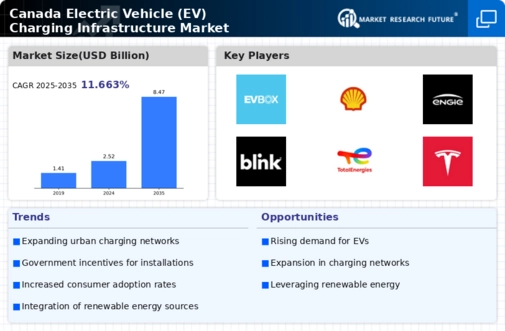Market Growth Projections
The Global Canada Electric Vehicle (EV) Charging Infrastructure Market Industry is poised for remarkable growth, with projections indicating a market size of 1.5 USD Billion in 2024 and an impressive escalation to 12 USD Billion by 2035. This growth trajectory suggests a compound annual growth rate (CAGR) of 20.81% from 2025 to 2035, reflecting the increasing demand for electric vehicles and the corresponding need for robust charging infrastructure. The anticipated expansion highlights the importance of strategic investments in charging solutions to meet the evolving needs of consumers and businesses alike.
Rising Consumer Demand for EVs
Consumer demand for electric vehicles is on the rise, driving the Global Canada Electric Vehicle (EV) Charging Infrastructure Market Industry forward. As awareness of environmental issues grows, more Canadians are opting for EVs, leading to an increased need for accessible charging stations. This trend is supported by the fact that the number of electric vehicles in Canada is expected to grow significantly in the coming years. The anticipated growth in EV adoption necessitates a robust charging infrastructure, which is projected to expand in tandem with the market, potentially reaching 12 USD Billion by 2035. This burgeoning demand underscores the importance of a comprehensive charging network.
Government Incentives and Policies
The Global Canada Electric Vehicle (EV) Charging Infrastructure Market Industry benefits significantly from government incentives and policies aimed at promoting electric vehicle adoption. Canadian federal and provincial governments have implemented various programs that provide financial support for EV charging infrastructure development. For instance, the Zero-Emission Vehicle Infrastructure Program allocates funds to enhance charging networks across the country. This support is crucial as the market is projected to reach 1.5 USD Billion in 2024, with expectations of expanding to 12 USD Billion by 2035. Such initiatives not only stimulate investment but also encourage consumers to transition to electric vehicles.
Urbanization and Infrastructure Development
Urbanization and ongoing infrastructure development are significant drivers of the Global Canada Electric Vehicle (EV) Charging Infrastructure Market Industry. As cities expand and populations increase, the demand for efficient transportation solutions rises, leading to a greater need for EV charging stations. Urban areas are increasingly integrating charging infrastructure into new developments, ensuring that residents have convenient access to charging facilities. This trend is likely to accelerate the adoption of electric vehicles, further stimulating market growth. The anticipated market size of 12 USD Billion by 2035 reflects the critical role that urban planning plays in supporting EV infrastructure.
Technological Advancements in Charging Solutions
Technological advancements are playing a pivotal role in shaping the Global Canada Electric Vehicle (EV) Charging Infrastructure Market Industry. Innovations such as fast-charging stations and smart charging technologies enhance the user experience and reduce charging times, making EVs more appealing to consumers. The integration of renewable energy sources into charging stations further aligns with sustainability goals. As these technologies evolve, they are expected to attract more investments, contributing to the market's growth. The market is projected to grow at a CAGR of 20.81% from 2025 to 2035, indicating a strong potential for technological integration in the charging infrastructure.
Environmental Regulations and Sustainability Goals
Environmental regulations and sustainability goals are crucial factors influencing the Global Canada Electric Vehicle (EV) Charging Infrastructure Market Industry. The Canadian government has set ambitious targets for reducing greenhouse gas emissions, which include increasing the adoption of electric vehicles. These regulations compel businesses and municipalities to invest in EV charging infrastructure to comply with environmental standards. As a result, the market is expected to experience substantial growth, with projections indicating a rise to 1.5 USD Billion in 2024 and 12 USD Billion by 2035. This regulatory environment fosters a culture of sustainability, driving further investments in charging infrastructure.





















Leave a Comment